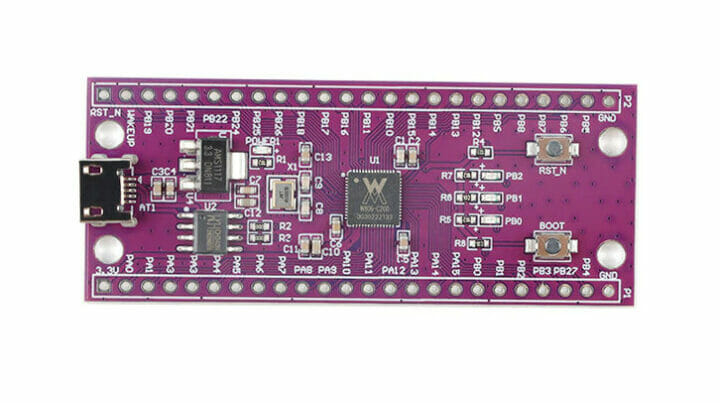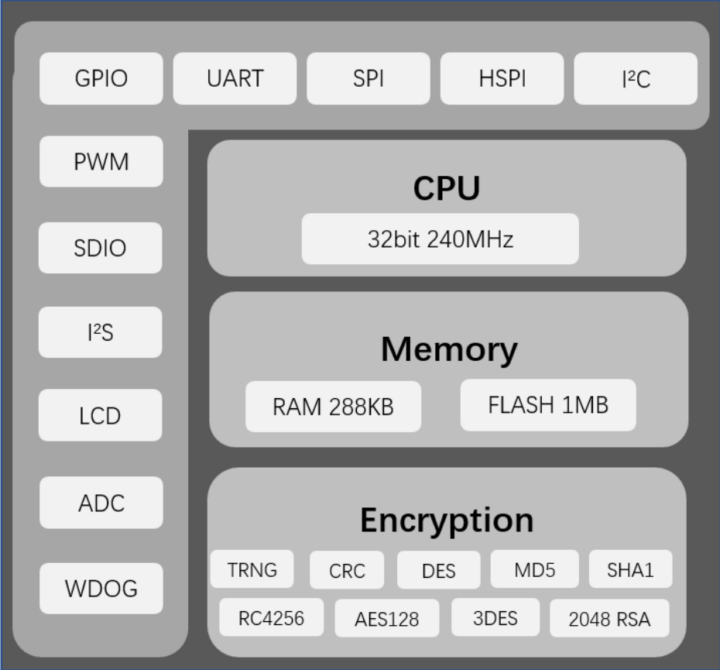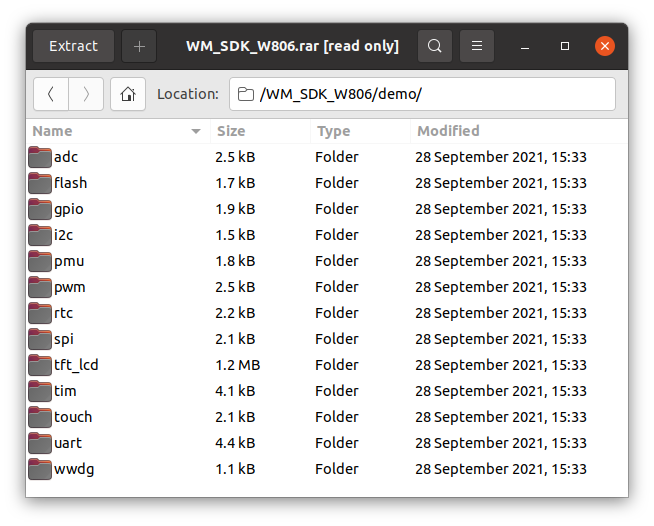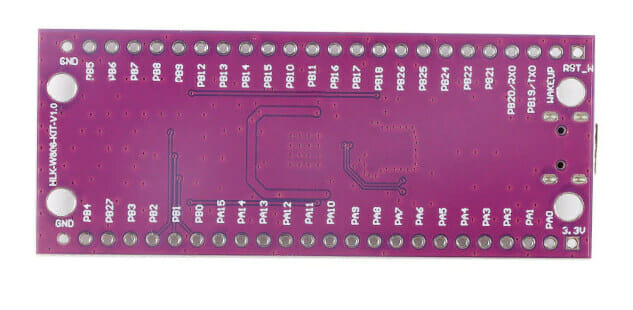I’ve just been notified about an inexpensive board (HLK-W806) based on WinnerMicro W806 32-bit XT804 (XuanTie E804) microcontroller clocked at up to 240 MHz and equipped with 1MB flash and 288KB RAM.
XuanTie is the microcontroller family from Alibaba’s subsidiary T-Head Semiconductor, notably XuanTie RISC-V cores, but I’ve just learned not all XuanTie cores are based on the RISC-V architecture, and as we’ll see below, Xuantie E804 core appears to be based on the C-Sky architecture. It may still be interesting, as it’s in the STM32 board price range (pre-2020), but with a much higher frequency, so let’s have a look.
 HLK-W806 development board specifications:
HLK-W806 development board specifications:
- MCU – WinnerMicro W806 32-bit XT804 microcontroller @ 240 MHz with 1MB Flash, 288KB RAM, FPU, DSP, crtypto engine
- Expansion – 2x 24-pin headers with (based on MCU specs)
- 1x SDIO host with support for SDIO 2.0, SDHC, MMC 4.2
- 1x SDIO device up to 200 Mbps
- Up to 6x UART, 1x I2C
- 1x SPI slave up to 50 MHz, 1x master/slave SPI
- LCD controller with support for 4×32 interface
- 1x I2S
- Up to 4x ADC (16-bit, 1KHz sampling rate)
- Up to 44x GPIOs, 5x PWM
- Up to 15 touch sensors
- ISO/IEC 7816 smart card interface
- Reset, Wakeup, 3.3V, and GND signals
- Debugging – CH340 via micro USB port
- Misc – Reset and Boot buttons
- Power Supply – 5V via micro USB port
- Dimensions – 65 x 26 mm (Almost the same size as a Raspberry Pi Zero, but not quite as wide)

The WinnerMicro W804 comes in a QFN56 (5×5) package, and in the specifications above, I assumed all interfaces were made available via the 48-pin headers. What was harder to find is documentation… The first page presented to me after a web search asked me to join QQ group 739265828, which I did not feel like doing, and it appears there’s a trend to make development tools hard and cumbersome to use…
But eventually, I came across a Reddit thread about this very board, where I learned that XuanTie E804 is C-Sky ISA, not RISC-V, and got a link to some useful documentation with notably W806 datasheet and even one SDK with libraries and C programs for each peripheral. Somehow the company promotes W806 as an “IoT” microcontroller despite having no wireless or wired communication interfaces.
 HKL-W806 board can be purchased for a little over $2 on Aliexpress, where you’ll also find the MCU for $1.59. The price in China is lower with the board going for under 8.9 RMB ($1.4) and the chip for 5.93 RMB (93 cents) on Taobao.
HKL-W806 board can be purchased for a little over $2 on Aliexpress, where you’ll also find the MCU for $1.59. The price in China is lower with the board going for under 8.9 RMB ($1.4) and the chip for 5.93 RMB (93 cents) on Taobao.
Thanks to Freire for the tip.

Jean-Luc started CNX Software in 2010 as a part-time endeavor, before quitting his job as a software engineering manager, and starting to write daily news, and reviews full time later in 2011.
Support CNX Software! Donate via cryptocurrencies, become a Patron on Patreon, or purchase goods on Amazon or Aliexpress. We also use affiliate links in articles to earn commissions if you make a purchase after clicking on those links.






this is very interesting. the biggest problem with Chinese MCU is – will it be available in the future or vanish without notice, no one knows? another one is documentation and support remain so poor, you don’t get much motivation.
That’s particularly of a concern when you see a 400 page datasheet entirely written in Chinese, indicating that the product was never meant for exportation at all!
For me CH340 is show stopper. A lot of my projects need fast USB communication with windows or linux system. It also limits usability of hardware encryption acceleration.
Also, it would be handy if vendors list PWM frequency, not just number of PWM pins.
PWM frequency is 3Hz~160KHz, according to its manual
This just smells like “we don’t want to deal with Cortex-M7 licensing” kind of STM32 clone.
Especially since there are some issues with ARM in China ^^
ARM in China or ARM China?
ESP32 crushes all. Unless they can do better why even bother.
I know above one is an easy target, but what makes ESP32 a good competitor to other microcontrollers? I don’t mind presence of wireless or parallel port, so what else is great about this chip?
Cheap, well documented, plenty of software support, good community, decent vendor support, readily available, vendor is actively involved in making new products and listens to even hobbiests.
And apparently they support cnx-software! 🙂
https://www.cnx-software.com/2021/11/09/esp8266-modules-are-still-selling-in-the-millions/
Haha. This is sponsored by A.I Thinker, not by Espressif 🙂
Goes to show how bit the market is if the ecosystem is being pushed by an OEM and not the original vendor.
ESP32 is garbage for realtime tasks. Try and time something with sub microsecond accuracy using the bloated esp-idf
Can you propose an alternative?
There is a SDK with peripheral demos on Github that you can have a try https://github.com/IOsetting/wm-sdk-w806
You can find CDK IDE used for this microcontroller and for GD32VF103
https://www.mediafire.com/file/wc4brpwkouotw1k/cdk-windows-V2.8.7-20210507-1704.zip/file
That’s the same SDK as on HLKTech website.
Yes, same SDK but higher version. The SDK on hlktech is v0.3.0, never been updated.
The issue with Chinese they use Baidu it is hard to download , also i didn’t mentioned that this CDK debugger option easy to use you can find the USB probe at GitHub just search for Cklink_lite you will find everything you need sch pcb and firmware it is based on stm32f103 you may use blue pill for prototype .now we need to wait for English data sheet to experiment with all abilities for this MCU
There now is a wireless variant of the W806 available called W801.
Review of the chip and differences on a Chinese blog https://www.cnblogs.com/milton/p/15621540.html
Available for $4.74 https://fave.co/3lh39vF